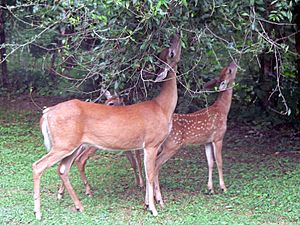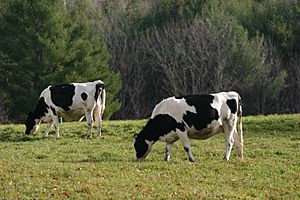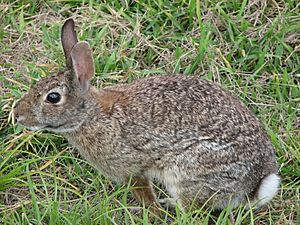Herbivore facts for kids
Herbivores are animals that only eat plants. You can also call them herbivorous animals. These animals get all their energy and nutrients from plants.
Some common herbivores include deer, elephants, and horses. Their teeth are specially made to grind up plant material. While many herbivores mostly eat fruits and leaves, they might also munch on other plant parts like roots and seeds. Generally, herbivores cannot digest meat. However, some might occasionally eat eggs or other small bits of protein from animals.
There are different types of herbivores based on what they eat most:
- Frugivores mainly eat fruit.
- Browsers prefer eating leaves and sometimes small tree branches.
- Grazing animals mostly eat grass.
The diet of some herbivores changes depending on the season. For example, in places with hot summers and cold winters, different plants are available at different times of the year. This means herbivores have to be flexible with their food choices.
Humans are omnivores, meaning they eat both plants and meat. People who choose to eat mostly plants are often called vegetarians or vegans.
Contents
How Herbivores Digest Plants
Plant cell walls are mostly made of a tough material called cellulose. Animals cannot digest cellulose on their own. So, how do herbivores do it? They have special helpers called gut flora (tiny living things like bacteria) in their stomachs or intestines. Some of these tiny helpers produce an enzyme called cellulase, which breaks down cellulose. This teamwork between the animal and the gut flora is a great example of symbiosis.
Herbivores and Plants: A Balancing Act
The relationship between herbivores and plants is like a natural cycle. When there are lots of plants (the "prey"), the number of herbivores (the "predators") goes up because there's plenty of food. But as herbivores eat more plants, the plant population goes down. This then causes the herbivore numbers to drop because there isn't enough food for everyone. Eventually, the plant population recovers, and the cycle starts all over again. This shows that the number of herbivores usually stays balanced around how much food the plants can provide.
Sometimes, there are small groups of plants that herbivores don't find. This is important for herbivores that only eat one type of plant. It stops them from eating all their food source and making it disappear. Eating more than one type of plant helps herbivore populations stay steady. If an animal or plant from another area enters an ecosystem, it can upset this balance and change the types of living things found there.
In some ways, being an herbivore is easier than being a carnivore (a meat-eating animal). Carnivores have to hunt and catch their food, which can be dangerous. Herbivores just need to find the plants they want to eat, and plants don't usually fight back! However, many plants have ways to protect themselves from herbivores, like spines, toxins (poisons), or a bad taste. There are many more herbivorous animals in the world than carnivorous animals.
Different Ways Herbivores Eat
Herbivores use different ways to eat. Two main strategies are grazing and browsing.
- A grazer mainly eats grass, making up at least 90% of its diet. Think of cows!
- A browser eats mostly tree leaves and twigs, also at least 90% of its diet. Moose are good examples of browsers.
Some herbivores are "selective," meaning they choose their food carefully. They might pick different plants depending on the season or what food is available. They also tend to choose plants that are high in nutrients first. Many herbivores don't just stick to one eating strategy; they use several and eat different parts of plants.
Types of Herbivore Diets
| Feeding Strategy | What They Eat | Example |
|---|---|---|
| Algivores | Algae | krill, crabs, sea snails |
| Frugivores | Fruit | Ruffed lemurs |
| Folivores | Leaves | Koalas |
| Nectarivores | Nectar (sweet liquid from flowers) | Honey possum |
| Granivores | Seeds | Hawaiian honeycreepers |
| Palynivores | Pollen | Bees |
| Mucivores | Plant fluids, like sap | Aphids |
| Xylophages | Wood | Termites |
Examples of Herbivores
Here are some animals that are herbivores:
- Goats
- Cows
- Horses
- Deer
- Rhinoceros
- Wildebeest (also called Gnu)
- Monkeys
- Sheep
- Iguanas
- Rabbits
- Pandas
- Koalas
Related pages
Images for kids
-
A sawfly larva feeding on a leaf.
-
A fossil Viburnum lesquereuxii leaf with signs of insect herbivory; from the Dakota Sandstone (Cretaceous) in Kansas. The scale bar is 10 mm.
-
Leaf miners eat leaf tissue between the outer layers, leaving visible trails.
-
A mixed group of herbivorous fish feeding on a coral reef.
See also
 In Spanish: Herbívoro para niños
In Spanish: Herbívoro para niños










